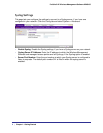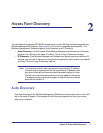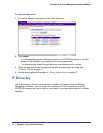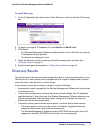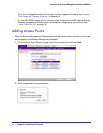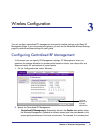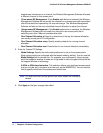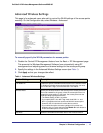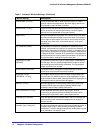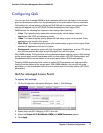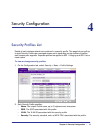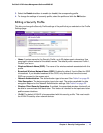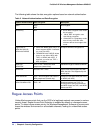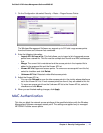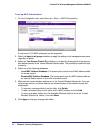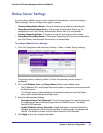
16 | Chapter 3: Wireless Configuration
ProSafe 5 AP Wireless Management Software WMS105
Channel Width (11n only) Select the available channel width of the access point. A wider
channel improves the performance, but some legacy devices can
only operate on either 20 MHz or 40 MHz.
Guard Interval (11n only) Select the value that protects transmissions from interference. A
shorter guard interval improves performance, but some legacy
devices can only operate with a long guard interval.
Output Power Select the available transmit power of the access point. This option
sets the transmit signal strength of the access point. Increasing the
power improves performance, but if two or more access points are
operating in the same area, on the same channel, it can cause
interference.
RTS Threshold (0-2347) The transmission mechanism (CSMA/CA or CSMA/CD) for the
packets. If the packet size is equal to or less than this threshold, the
data frame is transmitted immediately. However, if the packet size is
larger than the specified value, the transmitting station must send out
an Request to Send Threshold (RTS) packet to the receiving station,
and must wait for the receiving station to send back a CTS (Clear to
Send) packet before sending the actual packet data.
Fragmentation Length
(256-2346)
The maximum packet size used for fragmentation of data packets.
Packets larger than the specified fragmentation length are broken
into smaller packets before being transmitted. The fragmentation
length must be an even number.
Beacon Interval (100-1000) The interval time for each beacon transmission that allows the
access point to synchronize the wireless network.
Aggregation Length
(1024-65535, 11n only)
The length that defines the maximum length of Aggregated MAC
Protocol Data Unit (AMPDU) packets. Larger aggregation lengths
might sometimes lead to better network performance. Aggregation is
a mechanism used to achieve higher throughput.
AMPDU (11n only) Allow the aggregation of several MAC frames into a single large
frame to achieve higher throughput. Enabling AMPDU might
sometimes lead to better network performance.
RIFS Transmission (11n only) Enable Reduced Interframe Space (RIFS) option to allow
transmission of successive frames at different transmit powers.
Enabling RIFS might lead to better network performance.
DTIM Interval (1 and 255) Enter the desired DTIM or the data beacon rate. This indicates the
beacon delivery traffic indication message period in multiples of
beacon intervals.
Preamble Type (11b/bg only) A long transmit preamble might provide a more reliable connection or
a slightly longer range. A short transmit preamble gives better
performance. The Auto settings automatically handles both long and
short preambles. The default is Auto.
Table 1. Advanced Wireless Settings (Continued)
Field or Setting Description



